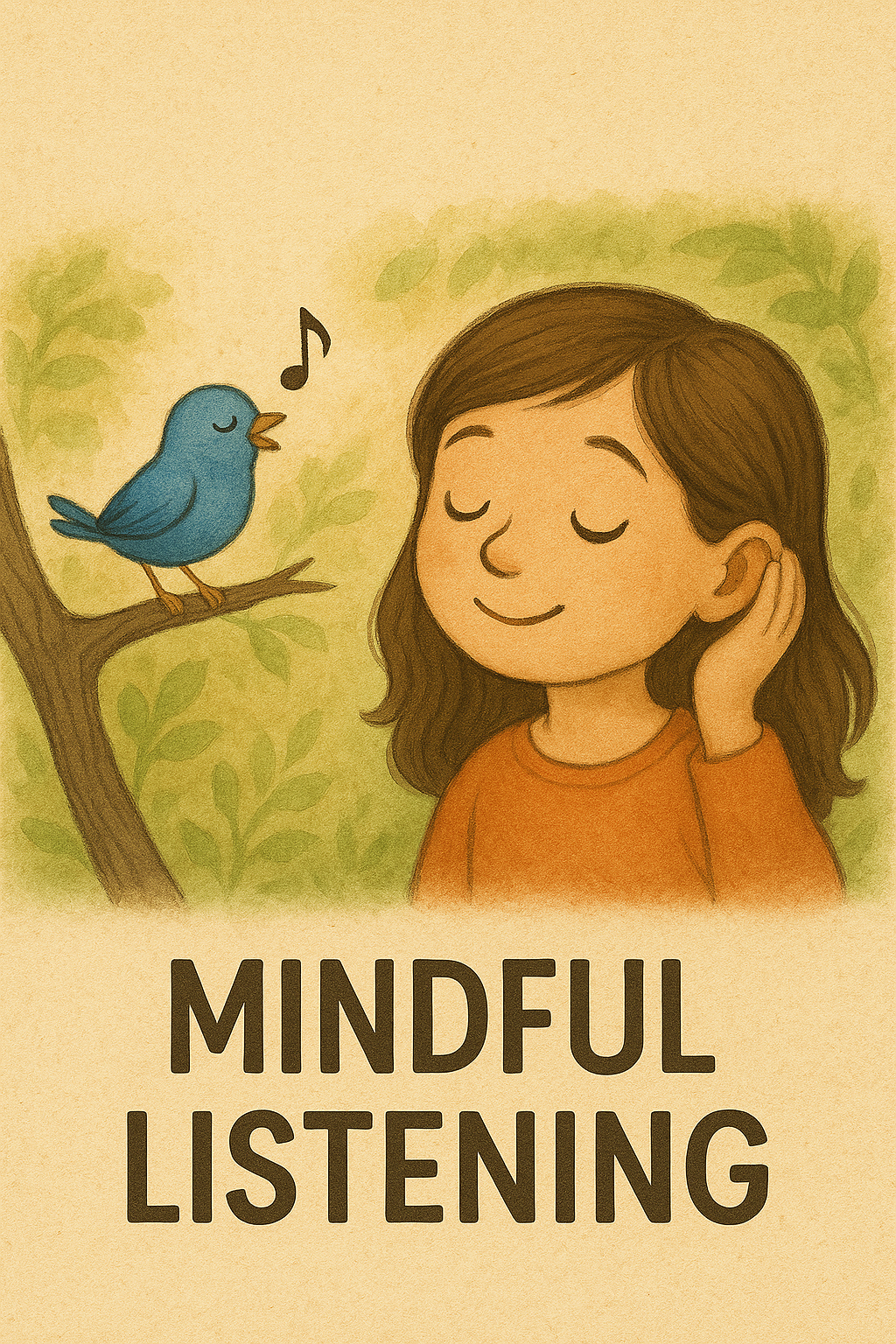Your basket is currently empty!

Helping Kids Tune In and Connect
Mindful Listening for Kids: Helping Children Tune In and Connect
Why Mindful Listening Matters
In today’s busy, screen-saturated world, mindful listening for kids is more important than ever. Children are surrounded by constant noise and distraction, and it can be hard for them to slow down enough to really listen. By teaching them to notice sounds with intention—whether it’s birdsong, a friend’s laughter, or even the quiet hum of the fridge—we give them a powerful tool for focus, calm, and connection.
Mindful listening isn’t just about hearing; it’s about paying attention fully in the moment. When kids learn this skill, they develop patience, empathy, and presence. They stop interrupting, start tuning in, and begin to appreciate the richness of the world around them.
The Benefits of Mindful Listening for Kids
Practising mindful listening brings both immediate and long-term benefits:
- Emotional awareness – Children notice the tone and feeling behind words, helping them recognise emotions in themselves and others.
- Stronger concentration – Listening mindfully trains the brain to focus, making it easier to pay attention at school or during play.
- Healthier relationships – Kids who practise listening tend to be more respectful, understanding, and empathetic with friends and family.
- More calm, less stress – Sound can anchor children in the present moment, reducing anxiety and helping them feel centred.
Fun Activities to Teach Mindful Listening
Mindful listening for kids doesn’t have to feel like a lesson—it can be playful and enjoyable. Here are a few simple activities you can try at home, in the classroom, or outside:
- Sound scavenger hunt
Ask your child to close their eyes and list all the sounds they can hear. Afterwards, share what each of you noticed. - Music focus
Put on a favourite piece of music and listen closely. Ask your child to spot instruments, rhythms, or parts of the song they hadn’t noticed before. - “What can you hear right now?” moments
Pause during the day—before bed, on a walk, or while cooking—and spend 30 seconds tuning into sounds. - Listening journal
Encourage your child to keep a journal where they write or draw sounds they noticed that day. Our Feelings Journal is a great tool for building this habit and connecting listening with emotional awareness. - Story listening
While reading aloud, invite kids to notice the sounds described in the story and share how they made them feel. - Games for fun practice
Try classics like “telephone,” or create a sound-matching game where children guess the source of different noises.
Everyday Ways to Build the Habit
Mindful listening becomes most powerful when it’s woven naturally into daily life. Here are a few simple ways to make it part of your routine:
- Morning & bedtime rituals – Start or end the day with one minute of quiet listening.
- Nature walks – Encourage your child to notice the rustle of leaves, birdsong, or flowing water.
- Car journeys – Turn off the radio and play “what do you hear?” with the sounds outside.
- Unplugged time – Switch off screens for a while and notice the sounds of the home environment.
Common Challenges and Solutions
| Challenge | What to Try |
|---|---|
| Kids are restless or bored | Start small: 30 seconds to 2 minutes. Keep it playful. |
| Sounds are hard to notice | Begin with obvious ones (cars, birds) before moving to subtle ones (wind, insects). |
| Lack of interest | Use games, music, or sibling participation to keep it fun. |
| Expressing what they heard | Encourage drawing as well as words. Praise noticing, not “correct answers.” |
Why Families and Classrooms Benefit
When children practise mindful listening, it doesn’t just help them individually—it changes the atmosphere at home and at school. Conversations become calmer, misunderstandings are reduced, and children show greater patience and empathy.
Mindful listening is also a great entry point into other mindfulness practices. If you’d like to build on this, check out our post on mindful breathing for kids or explore our guide to mindful journaling for kids and the importance of reflection. These practices work beautifully alongside listening to create a well-rounded approach to mindfulness.
Tips for Parents and Teachers
- Model the practice – Let children see you pausing and listening with attention.
- Ask reflective questions – Try: “What was your favourite sound today?” or “Did you hear something surprising?”
- Create a quiet listening corner – A calm spot free of distractions helps kids focus.
- Celebrate the effort – Praise the act of noticing, rather than the result.
Key Takeaways
- Mindful listening for kids helps them build focus, empathy, calm, and presence.
- It can be practised through simple games, music, journaling, and nature walks.
- Short daily practices are more effective than occasional long ones.
- Parents and teachers play a vital role by modelling and encouraging listening habits.
Mindful listening for kids is more than a technique—it’s a gift of presence. By helping children slow down and truly listen, we give them skills that will serve them for life: deeper empathy, stronger focus, and a calm centre they can always return to.
For more ideas, explore our full collection of mindful kids practices and discover tools like the Feelings Journal, designed to make mindfulness playful, engaging, and part of everyday life.